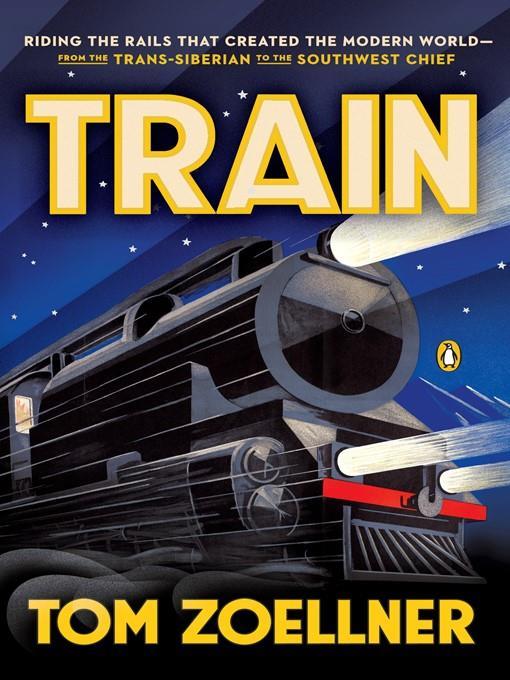
Train
Riding the Rails That Created the Modern World - from the Trans-Siberian to the Southwest Chief
- اطلاعات
- نقد و بررسی
- دیدگاه کاربران
نقد و بررسی

April 21, 2014
Author and educator Zoellner may love trains more than any man alive. In his traveler's guide and history of railroading, Zoellner journeys to the world's forgotten locomotive landmarks, riding the rails as much as humanly possible "to see the flickering landscape through their eyes" and brings the reader a unique perspective on the past, present, and future of locomotion. He begins with the earliest European railroads and details the effects trains have had on countries like Indiaâspurred to international prominence through British-built tracksâand the jolting manner in which high-speed trains have evolved in the twenty-first centuryâapplauded in Spain and Japan, hotly debated in the United States. Zoellner's pro-train bias is never unclear as he often launches into rhapsodic prose; passages like "the softest glow in the worldâ¦making the horizon smudgy with obscure whites and grays" are common, and the author recounts many experiences with fellow passengers that support his portrayal of trains as a bastion of whirlwind socialization. Perhaps too much attention is paid to this romantic depiction at the expense of solid answers about the usefulness of trains today, but Zoellner still constructs an absorbing history lesson that allows readers to draw their own conclusions.

December 15, 2013
A rousing around-the-world paean to the rumble of the rails by accomplished journalist Zoellner (A Safeway in Arizona: What the Gabrielle Giffords Shooting Tells Us About the Grand Canyon State and Life in America, 2011, etc.). The author, who commutes by train to his teaching job in Los Angeles, notes their utility in moving people and freight. Also, Zoellner finds trains good places to fall in love, if fleetingly, and to get reading and thinking done. Some of the things he thinks about are--well, things that it hasn't occurred to other writers to ask about, such as the decidedly detrimental effects human excrement has on the rail lines of India: First, it eats away at the metal, and then it attracts insects that eat rail ties, telephone and signal poles, and even railroad cars themselves. (The Hindi word for "this universal human output" is goo.) Mostly, Zoellner concentrates on less icky topics, and often to memorable effect, as when he writes of a foggy journey through northern England, "a J.R.R. Tolkien vision come to life" and an "eldritch scene" to boot. England may be a land of plains and valleys "with an occasional volcanic knob on which the ruins of a fortress might be standing and one where the occupants had almost certainly sucked all the wealth from the surrounding fields and converted it into magnificent furniture and swords," but America, with its continentally vast distances, has much catching up to do--for one thing, trains travel much slower here than they do elsewhere in the world. Having train-hopped across continents, Zoellner closes his account with a cleareyed look at what needs to happen in America if trains are to have a future--it will involve considerable infusions of money and overcoming vested-interest opposition. Great for fans of Paul Theroux's railroad journeys, except that Zoellner isn't anywhere near as ill-tempered, and he has a better command of social history. A pleasure for literate travelers.
COPYRIGHT(2013) Kirkus Reviews, ALL RIGHTS RESERVED.

February 1, 2014
Journalist and author Zoellner, who wrote about the shooting of Gabrielle Giffords (A Safeway in Arizona) and "the most powerful element in the world" (Uranium), takes to the rails in seven countries in this book. He looks at the state of this often underrated but essential mode of transportation, in places as different and far apart as Peru, India, Russia, the UK, Spain, China, and the United States. The author mixes his fascination for trains and the conversations he has with his fellow travelers (railway workers and enthusiasts, commuters, and Russian soldiers are just a few of the many people he meets) into a detailed story told with knowledge and enthusiasm. While the train has been used as a political tool in China, where the government has finally brought its massive railway network to Lhasa, the capital of Tibet, in an attempt to defuse the movement for independence, Spain has become the envy of other modern nations with its fast-growing infrastructure of bullet trains. VERDICT Zoellner's story, rich with history and local color, is a mesmerizing read for anyone interested in the impact of trains on the environment, politics, economics, and daily life around the world today.--Linda M. Kaufmann, Massachusetts Coll. of Liberal Arts Lib., North Adams
Copyright 2014 Library Journal, LLC Used with permission.

December 1, 2013
Despite ebbing enthusiasm for passenger rail travel in the U.S. these days, train companies remain major players in transporting consumer goods from coast to coast. Also, as veteran journalist and unabashed train fanatic Zoellner emphasizes in this exuberant celebration of these mammoth wheeled machines, both commuters and businesses overseas are still heavily dependent on trains, especially in countries like China, where rail service continues to expand almost exponentially. As a convenient excuse for research, Zoellner toured several of the world's most notable rail lines, including a north-to-south trek in Britain, a journey up corkscrewing tracks in the Peruvian Andes, and a jaunt on Russia's Trans-Siberian Railway. In between colorful anecdotes from his travels that include snapshots of contemporary commuters in countries from Scotland to India, Zoellner provides a wealth of fascinating historical details, such as the mood of astonishment that greeted the first trains in nineteenth-century England and the grim duty the railroads undertook during both world wars. An absorbing and lively reflection on an enduring marvel of modern industrial technology.(Reprinted with permission of Booklist, copyright 2013, American Library Association.)




دیدگاه کاربران